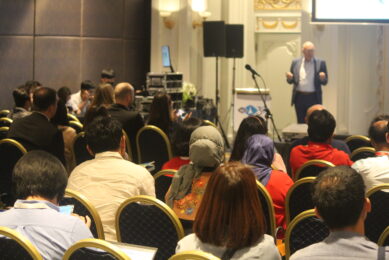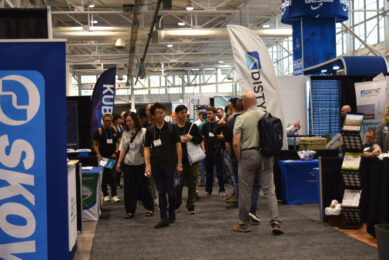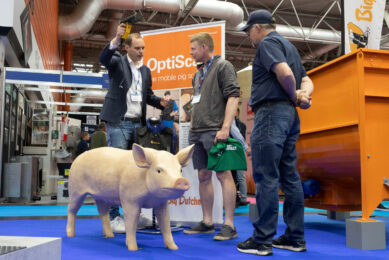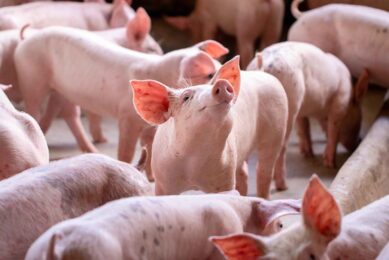Detecting fever with a phone app
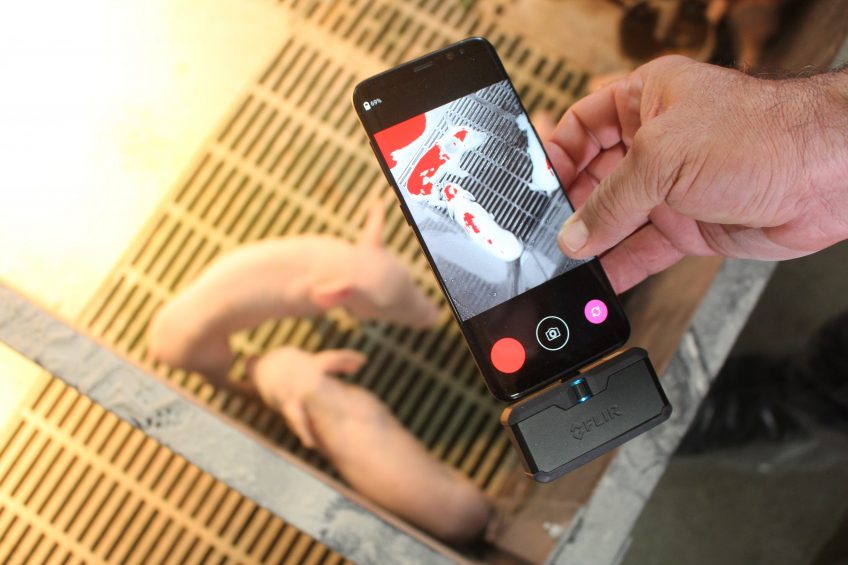
Mycoplasma suis, MMA, swine influenza, Classical Swine Fever or arthritis… The occurrence of fever is what all these health problems have in common. An exact diagnosis therefore is for a vet to make – but what if an app can help detect fever in a split second?
With the naked eye, is it possible to discern which pig is feverish? Guillermo Ramis is a full professor in animal production at the University of Murcia, Spain. With those credentials, one would say he’d be able to tell. Dressed in a biosecurity coverall and boots he looks around the pen. He points to one weaner with large black spots at the tips of both ears. “That one has ear necrosis. Fat chance he has fever.”
He then takes his phone and aims for the animal. On the screen, parts of the animal turn red, a sign that the device is reading the data of this particular pig. Immediately, also a large red dot appears at the bottom of the screen. The large red dot proves Prof Ramis’ estimate right.
A phone application to detect fever
Over the last two years, Prof Ramis has been working on a novelty which combines Precision Livestock Farming (PLF) principles with smartphones and yet at the same time keeps things simple. This EuroTier will see the launch of the ’Degree2act’ app, a simple phone application for iOS and Android, which helps swine producers detect animals that have fever quicker. That, in turn, can lead to earlier, more precise treatment or a quicker visit from a veterinarian.
Main driver behind the novelty is Xavier Vélez, marketing manager of the event and marketing services company Beinfive, headquartered in Barcelona, Spain. He is quick to explain that the app is definitely no diagnostics tool. Mr Vélez says, “It doesn’t tell you what disease an animal has, not at all. All it tells you is whether an animal needs individual care.”
Mr Vélez ended up in the world of animal health with a detour. His company is often involved in organising events for the swine industry and as such is very much aware of all kinds of new devices and tools which can help events be more professional. In an ongoing search of using new devices, he made use of thermographic cameras. The device was made by FLIR, the world’s largest company for thermographic cameras, based in Oregon, United States.
He connected the dots and wondered whether a tiny and affordable, portable version of the device could also be used for the swine business. After all, on the FLIR website, videos with a host of applications of thermographic cameras are being mentioned, from the army to firefighters. So why not agriculture?

Interpreting thermographically acquired data
With full approval of FLIR, Mr Vélez and Prof Ramis set out to develop an app that can interpret the thermographically acquired data in the pig house. The team decided to set standard values for 3 animal groups, being sows, weaned piglets and finishers. “On average, the temperature of sows is 38.3ºC, that of finishers is on average 39.3ºC and that of piglets of about 15-20 kg is at 39.5ºC, explains Prof Ramis. “On the farm of the University of Murcia, it took us 300 sows alone to properly calibrate the app for breeding animals, for instance. Now the more the application will be used in the future, the more precise it will get.”
The results of the measurements will be shown in a system that is identical to a traffic light. Green means – animals detected; yellow means – you had better watch this animal; red means – hyperthermia, check temperature. In the latter case, the particular pig can be marked for instance – and is easy to find it back for later treatment.
The application in sows
The farm visit takes place near Sant Boi de Lluçanès, at just over an hours’ drive north of Barcelona. The farm belongs to Sant Antoni, a Catalan feed mill which also has about 4,000 sows in own production.
A visit to the farrowing barn leads to identical results as described above. Armed with the phone, the thermographic camera added to it, and the app, in ‘sow’ mode now, Prof Ramis enters the facility. He scans a few sows and the third animal yields the well-known red dot at the bottom of the phone’s screen. San Antoni veterinarian Manuel Canal Casals looks over Prof Ramis’ shoulder and then peeks at the sheet of paper hanging above the sow: “It says that she received antibiotics and an anti-inflammatory medicine this morning. So there was indeed something wrong with her. Looks like the app got it right.”
Mr Casals was happy to receive Pig Progress and the Degree2act team to test out the device in public. Nevertheless, he had never heard of the app before, let alone seen it in practice, he says, and is impressed with what he sees. “It could be a very interesting app for us,” Mr Casals admits, having seen how it works. “Normally we have to use clinical signs to estimate whether an animal needs medication. With lactating sows it is still relatively easy: when she does not eat, there is something wrong with her. That is when we would give medication. But we aim to use as few antibiotics as possible on the farm, and this can certainly help to identify with even more precision which animals have fever.”
Group housing is where the most added value appears to be possible. After all, in larger groups of animals, like weaner pigs or finishers, it is not possible to observe which animal ate and which didn’t. There, a scan in the barn could provide results that may otherwise go unnoticed.

Future plans
The app is available in 2 different versions. A simple version, with just the scanning option, is aimed at producers and can help identify feverish animals. A more elaborated version, with also recording options as well as the possibility to take pictures and store them, is available for veterinarians, who thus can build their own archive of fever-related problems.
The team already has plenty of ideas for future expansion of the app. Currently the app only signals higher temperatures, but the Degree2act team hope to be able to add hypothermia problems to the app in the future as well. Perhaps then the traffic light warning system will also get a blue addition. In addition, most of the attention of the camera now goes to the animal’s backs, as they are easy to read. In the future, the team also hopes to expand the device with specific attention for e.g. teats or legs so that also local inflammations can be spotted.
Gestation barn
Prof Ramis enters the dry sow house. The animals are kept in crates for the first 30 days post-insemination. In the middle of the room is an infirmary, with several sows having been isolated. One is suffering from arthritis and indeed, the red dot pops up as soon as Prof Ramis aims for the animal.
A green dot appears at the two other isolated sows, however, although they are both located in an infirmary space. Prof Ramis repeats it a few more times, but every time a green dot appears. Interested, Mr Casals turns to his farm manager. “These animals were isolated, right? What was wrong with them then?” The farm manager replies: “True – these sows are in there because they were fighting. A bit of aggression. That is why we put them apart!”
A FLIR One thermographic camera add-on is available at the one-time investment of about € 250-€ 475; the Degree2act app (for Android and iOS) can be downloaded for free and its use costs a monthly subscription. Degree2act can be found at EuroTier in hall 16, booth G07.



